The AMD Radeon R9 290X Review
by Ryan Smith on October 24, 2013 12:01 AM EST- Posted in
- GPUs
- AMD
- Radeon
- Hawaii
- Radeon 200
GRID 2
The final game in our benchmark suite is also our racing entry, Codemasters’ GRID 2. Codemasters continues to set the bar for graphical fidelity in racing games, and with GRID 2 they’ve gone back to racing on the pavement, bringing to life cities and highways alike. Based on their in-house EGO engine, GRID 2 includes a DirectCompute based advanced lighting system in its highest quality settings, which incurs a significant performance penalty but does a good job of emulating more realistic lighting within the game world.
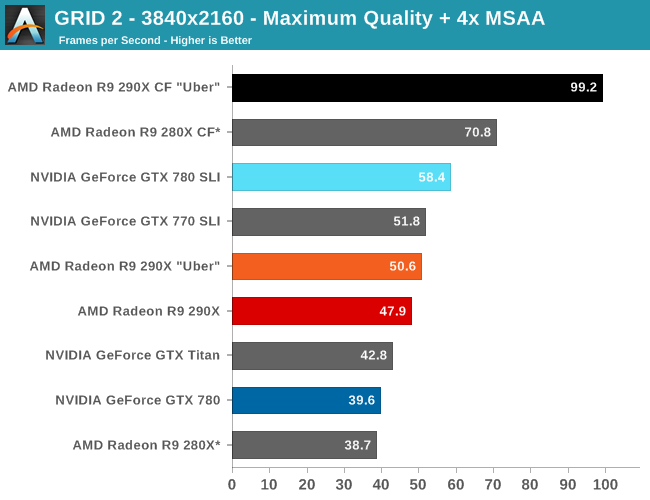
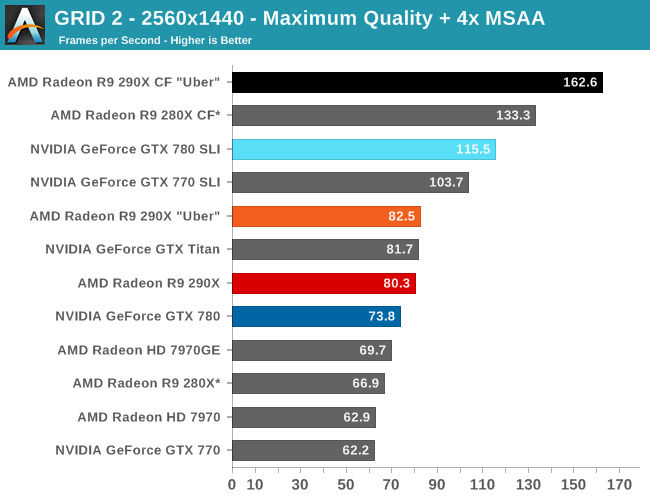
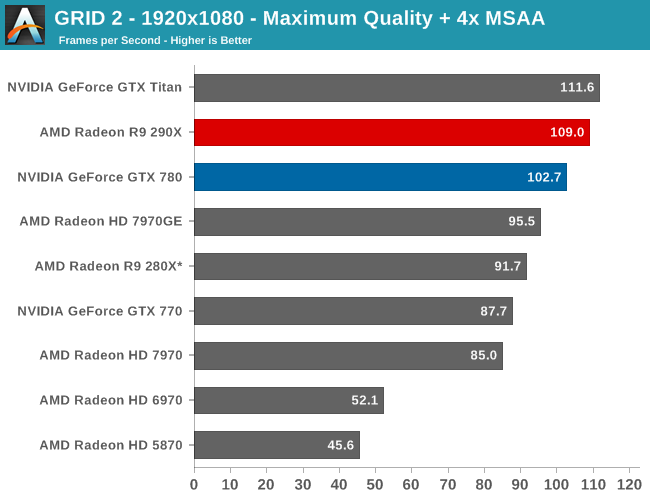
For as good looking as GRID 2 is, it continues to surprise us just how easy it is to run with everything cranked up, even the DirectCompute lighting system and MSAA (Forward Rendering for the win!). At 2560 the 290X has the performance advantage by 9%, but we are getting somewhat academic since it’s 80fps versus 74fps, placing both well above 60fps. Though 120Hz gamers may still find the gap of interest.
Moving up to 4K, we can still keep everything turned up including the MSAA, while pulling off respectable single-GPU framerates and great multi-GPU framerates. To no surprise at this point, the 290X further extends its lead at 4K to 21%, but as usually is the case you really want two GPUs here to get the best framerates. In which case the 290X CF is the runaway winner, achieving a scaling factor of 96% at 4K versus NVIDIA’s 47%, and 97% versus 57% at 2560. This means the GTX 780 SLI is going to fall just short of 60fps once more at 4K, leaving the 290X CF alone at 99fps.
Unfortunately for AMD their drivers coupled with GRID 2 currently blows a gasket when trying to use 4K @ 60Hz, as GRID 2 immediately crashes when trying to load with 4K/Eyefinity enabled. We can still test at 30Hz, but those stellar 4K framerates aren’t going to be usable for gaming until AMD and Codemasters get that bug sorted out.
Finally, it’s interesting to note that for the 290X this is the game where it gains the least on the 280X. The 290X performance advantage here is just 20%, 5% lower than any other game and 10% lower than the average. The framerates at 2560 are high enough that this isn’t quite as important as in other games, but it does show that the 290X isn’t always going to maintain that 30% lead over its predecessor.
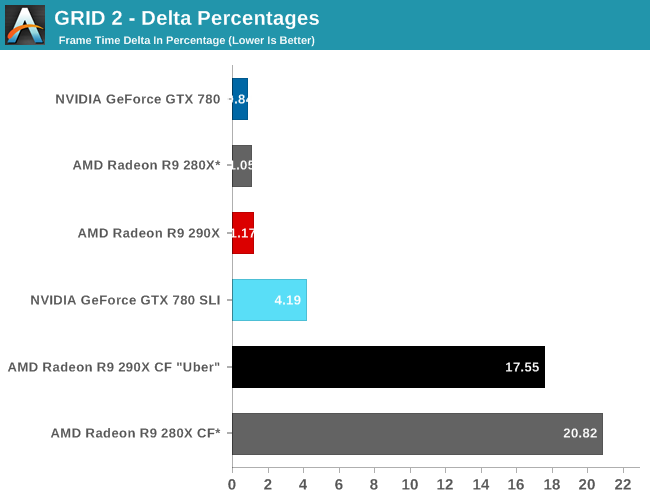
Without any capturable 4K FCAT frametimes, we’re left with the delta percentages at 2560, which more so than any other game are simply not in AMD’s favor. The GTX 780 SLI is extremely consistent here, to the point of being almost absurdly so for a multi-GPU setup. 4% is the kind of variance we expect to find with a single-GPU setup, not something incorporating multiple GPUs. AMD on the other hand, though improving over the 280X by a few percent, is merely adequate at 17%. The low frame times will further reduce the real world impact of the difference between the GTX 780 SLI and 290X CF here, but this is another game AMD could stand some improvements, even if it costs AMD some of the 290X’s very strong CF scaling factor.


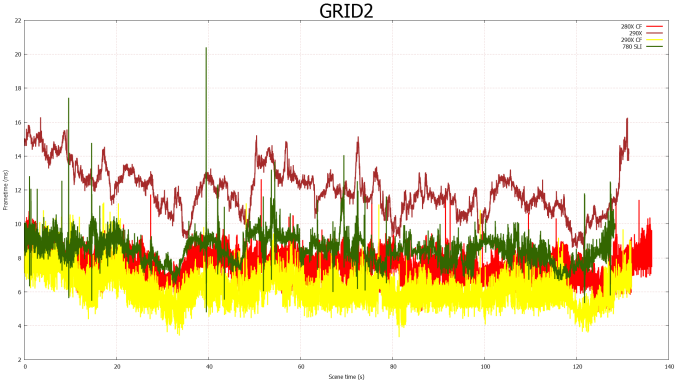








396 Comments
View All Comments
Sandcat - Thursday, October 24, 2013 - link
Perhaps they knew it was unsustainable from the beginning, but short term gains are generally what motivate managers when the develop pricing strategies, because bonus. Make hay whilst the sun shines, or when AMD is 8 months late.chizow - Saturday, October 26, 2013 - link
Possibly, but now they have to deal with the damaged goodwill of some of their most enthusiastic, spendy customers. I can't count how many times I've seen it, someone saying they swore off company X or company Y because they felt they got burned/screwed/fleeced by a single transaction. That is what Nvidia will be dealing with going forward with Titan early adopters.Sancus - Thursday, October 24, 2013 - link
AMD really needs to do better than a response 8 months later to crash anyone's parade. And honestly, I would love to see them put up a fight with Maxwell at a reasonable time period so they have incentive to keep prices lower. Otherwise, expect Nvidia to "overprice" things next generation as well.When they have no competition for 8 months it's not unsustainable to price as high as the market will bear, and there's no real evidence that Titan was economically overpriced because it's not like there was a supply glut of Titans sitting around anywhere, in fact they were often out of stock. So really, Nvidia is just pricing according to the market -- no competition from AMD for 8 months, fastest card with limited supply, why WOULD they price it at anything below $1000?
chizow - Saturday, October 26, 2013 - link
My reply would be that they've never had to price it at $1000 before, and we have certainly seen this level of advancement from one generation to the next in the past (7900GTX to 8800GTX, 8800GTX to GTX 280, 280 GTX to 480 GTX, etc), so it's not completely ground-breaking performance increases even though Kepler overall outperformed historical improvements by ~20%, imo.Also, the concern with Titan isn't just the fact it was priced at ungodly premiums this time around, it's the fact it held it's crown for such a relatively short period of time. Sure Nvidia had no competition at the $500+ range for 8 months, but that was also the brevity of Titan's reign at the top. In the past, a flagship in that $500 or $600+ range would generally reign for the entire generation, especially one that was launched half way through that generation's life cycle. Now Nvidia has already announced a reply with the 780 Ti which will mean not one, but TWO cards will surpass Titan at a fraction of it's price before the generation goes EOL.
Nvidia was clearly blind-sided by Hawaii and ultimately it will cost them customer loyalty, imo.
ZeDestructor - Thursday, October 24, 2013 - link
$1000 cards are fine, since the Titan is a cheap compute unit compared to the Quadro K6000 and the 690 is a dual-GPU card (Dual-GPU has always been in the $800+ range).What we should see is the 780 (Ti?) go down in price and match the R9-290x, much to the rejoicing of all!
Nvidia got away with $650-750 on the 780 because they could, and THAT is why competition is important, and why I pay attention to AMD even if I have no reason to buy from them over Nvidia (driver support on Linux is a joke). Now they have to match. Much of the same happens in the CPU segement.
chizow - Saturday, October 26, 2013 - link
For those that actually bought the Titan as a cheap compute card, sure Titan may have been a good buy, but I doubt most Titan buyers were buying it for compute. It was marketed as a gaming card with supercomputer guts and at the time, there was still much uncertainty whether or not Nvidia would release a GTX gaming card based on GK110.I think Nvidia preyed on these fears and took the opportunity to launch a $1K part, but I knew it was an unsustainable business model for them because it was predicated on the fact Nvidia would be an entire ASIC ahead of AMD and able to match AMD's fastest ASIC (Tahiti) with their 2nd fastest (GK104). Clearly Hawaii has turned that idea on it's head and Nvidia's premium product stack is crashing down in flames.
Now, we will see at least 4 cards (290/290X, 780/780Ti) that all come close to or exceed Titan performance at a fraction of the price, only 8 months after it's launch. Short reign indeed.
TheJian - Friday, October 25, 2013 - link
The market dictates pricing. As they said, they sell every Titan immediately, so they could probably charge more. But that's because it has more value than you seem to understand. It is a PRO CARD at it's core. Are you unaware of what a TESLA is for $2500? It's the same freaking card with 1 more SMX and driver support. $1000 is GENEROUS whether you like it or not. Gamers with PRO intentions laughed when they saw the $1000 price and have been buying them like mad ever since. No parade has been crashed. They will continue to do this pricing model for the foreseeable future as they have proven there is a market for high-end gamers with a PRO APP desire on top. The first run was 100,000 and sold in days. By contrast Asus Rog Ares 2 had 1000 unit first run and didn't sell out like that. At $1500 it really was a ripoff with no PRO side.I think they'll merely need another SMX turned on and 50-100mhz for the next $1000 version which likely comes before xmas :) The PRO perf is what is valued here over a regular card. Your short-lived statement makes no sense. It's been 8 months, a rather long life in gpus when you haven't beaten the 8 month old card in much (I debunked 4k crap already, and pointed to a dozen other games where titan wins at every res). You won't fire up Blender, Premiere, PS CS etc and smoke a titan with 290x either...LOL. You'll find out what the other $450 is for at that point.
chizow - Saturday, October 26, 2013 - link
Yes and as soon as they released the 780, the market corrected itself and Titans were no longer sold out anywhere, clearly a shift indicating the price of the 780 was really what the market was willing to bear.Also, there are more differences with their Tesla counterparts than just 1 SMX, Titan lacks ECC support which makes it an unlikely candidate for serious compute projects. Titan is good for hobby compute, anything serious business or research related is going to spend the extra for Tesla and ECC.
And no, 8-months is not a long time at the top, look at the reigns of previous high-end parts and you will see it is generally longer than this. Even the 580 that preceded it held sway for 14-months before Tahiti took over it's spot. Time at the top is just one part though, the amount which Titan devalued is the bigger concern. When 780 launched 3 months after Titan, you could maybe sell Titan for $800. Now that Hawaii has launched, you could maybe sell it for $700? It's only going to keep going down, what do you think it will sell for once 780Ti beats it outright for $650 or less?
Sandcat - Thursday, October 24, 2013 - link
I noticed your comments on the Tahiti pricing fiasco 2 years ago and generally skip through the comment section to find yours because they're top notch. Exactly what I was thinking with the $550 price point, finally a top-tier card at the right price for 28nm. Long live sanity.chizow - Saturday, October 26, 2013 - link
Thanks! Glad you appreciated the comments, I figured this business model and pricing for Nvidia would be unsustainable, but I thought it wouldn't fall apart until we saw 20nm Maxwell/Pirate Islands parts in 2014. Hawaii definitely accelerated the downfall of Titan and Nvidia's $1K eagle's nest.